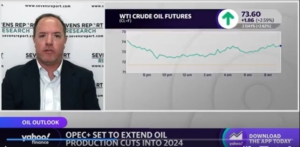The last thing Saudi Arabia wants right now is lower oil prices amid their already subdued output
The last thing Saudi Arabia wants right now is lower oil prices amid their already subdued output: Tyler Richey, Sevens Report Co-Editor, Quoted in MarketWatch on MSN
Crude oil extends losing streak as Trump urges OPEC to lower prices
While Trump is known to enjoy good relations with Saudi Crown Prince Mohammed bin Salman, but “the last thing Saudi Arabia wants right now… is lower oil prices amid their already subdued output, so they would not be likely to roll over and open the spigots without some sort of concessions – whether it be military [or] defense assets… or some other promise of U.S. investment in Saudi Arabia,” according to Tyler Richey, co-editor at Sevens Report Research.
Also, click here to view the full Seeking Alpha article published by MSN on January 24th, 2025. However, to see the Sevens Report’s full comments on the current market environment sign up here.
If you want research that comes with no long term commitment, yet provides independent, value added, plain English analysis of complex macro topics, then begin your Sevens Report subscription today by clicking here.
To strengthen your market knowledge take a free trial of The Sevens Report.
Join hundreds of advisors from huge brokerage firms like Morgan Stanley, Merrill Lynch, Wells Fargo Advisors, Raymond James, and more! To start your quarterly subscription and see how The Sevens Report can help you grow your business, click here.




 Why the Monthly OPEC Report Was Bearish Oil
Why the Monthly OPEC Report Was Bearish Oil